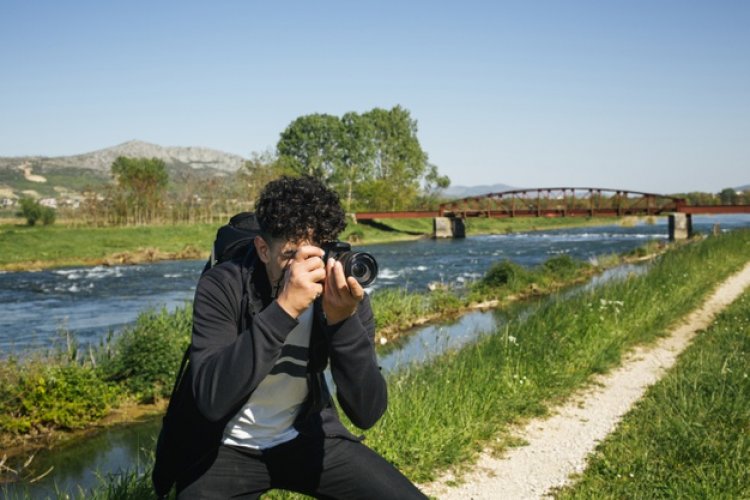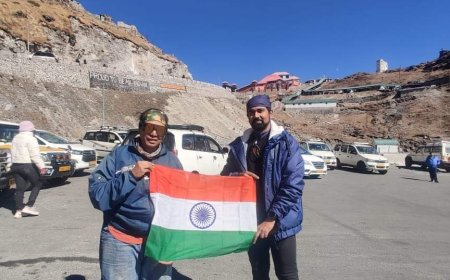Travel and Scenic Photography 101
When you are driving through the mountains somewhere, & you notice a automobile parked half off the road & some guy leaning to the left to avoid a branch with his Rebel 2000 camera in the act of focusing,

When you are driving through the mountains somewhere, & you notice a automobile parked half off the road & some guy leaning to the left to avoid a branch with his Rebel 2000 camera in the act of focusing, you have met me. I do this because, to me, a trip isn't fulfilling unless i have preserved that beauty for posterity. I'd like to share a quantity of the techniques that make scenic photography such a wonderful artform - simple, yet elegant.
First off, equipment. As much as the cheapo disposable camera beckons, get real. These cameras have fisheye lenses which I call "spam" lenses. we cram everything in, with equal blurriness & boringness. nice photos are sharp, unless you use blur for artistic effect. Sharp comes from an adjustable lens. It can be a fixed lens or a zoom, but it must focus specially for each picture. Fixed lenses are limiting for scenic pics, where to frame the shot you may require to move long distances. Imagine using a fixed lens on the Washington Monument, when you are half a block away! Zooms get my vote, even though we often don't have as wide an aperture, which limits their capabilities in low light situations.
Practically speaking, an SLR is the absolute best. we are lightweight, & can be used with top quality lenses. Film SLRs tend to be less expensive, but have the limitations of film, meaning you have to get it developed & so forth. Digital SLRs are VERY expensive, so for the budget conscious either go with a film SLR or a high quality basic digital camera. With digital, resolution is also a critical factor, so look at the specs before you buy.
OK, we have got the camera, emotions are jogging high, & that's great, but not great! sometimes I find a spot that's so wonderful, I start shooting like a madman, only to be disappointed by the pics. What happened? Emotions. When you experience a place, there are sounds, aromas & breezes as well as the visuals of the spot. Needless to say, you cannot photograph all of these elements, only the visual. When overwhelmed by the spectacle of a scenic hotspot, we are often overwhelmed by all of these elements.
Now, I was a tad dishonest in saying that you cannot capture all of the elements of a scene. You can hint at them. For starters, motion. Yes, even in a still picture, there's motion. Something happened before, during & after your picture. In a mountain vista scene, you may find something that hints at motion, whether it be a branch of a tree that has been swaying in the breeze, or a river flowing through the valley below. These add a sense of motion.
So what to do? Look through your camera. The viewfinder does not lie (usually). Try to see what you are looking at as the finished picture. Most people perfunctorily take pics, hoping that somehow the shot will come out great. If you wonder how the pics came out when you are on the way to the drugstore to get them, you are doing something wrong. At the moment you click the pic, you should know exactly what you will get. (Of work with digital, that's not a trick!).
Then there's the "rule of thirds." When you place the main object of the picture smack-dab in the middle, it is static & boring. Place it one third of the way from either side, & you IMPLY motion. Put the horizon in a landscape photo a third of the way up or down, not across the middle.
Remember, when a person looks at a picture, their eyes move. You require to frame your photo to help that movement. If you can find some lines in the scene, such as a skyline, cloud formation, path through the forest, etcetera, use it interestingly, & with the rule of thirds to draw your viewer's eyes into the picture.
Avoid "summit syndrome." You get to the top of Mount Washington & shoot the majestic vista. Great. The pics come out .. boring! How? No PERSPECTIVE. Big vistas will be flat unless you have an object in the foreground, such as a rock or a tree, to give them perspective. Then the eye grasps how big this scene is. People enjoying the view is a real winner, because the viewer may identify with their emotions, giving the image real impact.
Cheese! Yes, you do have to take the family photos. it is obligatory. But when you do, make sure that we show the location of the photo. Otherwise, you might as well do it on your driveway. Frame the scene in context, with landmarks as part of the picture. Find a way to tell as story in the picture, such as little Sara climbing up the rocks by the waterfall.
Finally, any element in the picture that hints at more senses than the visual will make it remarkable. Actor headshots for example, tell a story about the subject. You can hear them saying their next lines. If you photograph a garden, the viewer may experience the aroma of the flowers. A tourist street with an accordion player on the corner may have your amazed friends whistling "Dixie."
In summation, picture taking on travel is recording the experience in a satisfying way. Use motion, perspective, sensory, storytelling & so forth, to bring your photos to life. Oh, & needless to say, make your job easy & go to great places! See you at the overlook!
What's Your Reaction?



































































































